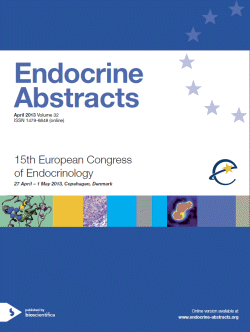Searchable abstracts of presentations at key conferences in endocrinology
Symposia
Female reproduction
ea0032s3.1 | Female reproduction | ECE2013
The transcription factor FOXL2 in ovarian physiology and pathology
The gene FOXL2 encodes a forkhead transcription factor whose mutations or misregulation are responsible for the blepharophimosis-ptosis-epicanthus inversus (BPES) syndrome and more recently have been associated with ovarian granulosa cell tumors (OGCT). BPES is a genetic disorder involving craniofacial abnormalities associated with premature ovarian failure. OGCTs are endocrine malignancies, accounting for up to 5% of ovarian cancers, the treatment of which is challenging. I w...
ea0032s3.2 | Female reproduction | ECE2013
NR5A1/SF-1 and gonadal development and function
Steroidogenic factor 1 (SF-1/NR5A1) is a regulator of steroid hormone biosynthesis and sex development. It was first identified in a 46,XY newborn with complete sex reversal and primary adrenal insufficiency. Most 46,XY patients carrying heterozygote NR5A1 mutations manifest with a disorder of sexual development (DSD) phenotype, although an adrenal only phenotype has also been described in one 46,XX patient. Mutations in NR5A1 may be found in up to 9% of 46,XY subjects with mi...
ea0032s3.3 | Female reproduction | ECE2013
Progestin action in the brain
Schumacher Michael , Sitruk-Ware Regine , Guennoun Rachida
The brain is an important target of progesterone. Already earlier studies consistently reported the presence of progesterone receptors (PR) throughout the brain. The wide distribution of brain PR has subsequently been confirmed by mRNA analysis, immunohistochemistry and more recently by immunoelectron microscopy. Surprisingly, the significance of the wide distribution of PR in the brain has largely remained unexplored, and only hypothalamic receptors have been extensively stud...




